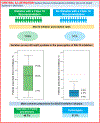Prescription Patterns for Sodium-Glucose Cotransporter 2 Inhibitors in U.S. Health Systems
- PMID: 39142721
- PMCID: PMC11789666
- DOI: 10.1016/j.jacc.2024.05.057
Prescription Patterns for Sodium-Glucose Cotransporter 2 Inhibitors in U.S. Health Systems
Abstract
Background: Sodium-glucose cotransporter 2 (SGLT2) inhibitors reduce heart failure (HF) hospitalizations, recurrent cardiovascular events, and chronic kidney disease (CKD) progression, and thus constitute a Class 1a recommendation in people with diabetes and atherosclerotic cardiovascular disease, HF, or CKD and in people with severe albuminuria or HF, regardless of diabetes status.
Objectives: The purpose of this study was to comprehensibly characterize the rate of SGLT2 inhibitor prescriptions among people with a Class 1a recommendation for SGLT2 inhibitor use.
Methods: Among 3,189,827 adults from 28 U.S. health systems within Optum Labs Data Warehouse between April 1, 2022, and March 31, 2023, we assessed SGLT2 inhibitor prescription rates, stratified by presence of diabetes and Class 1a recommendation.
Results: Among 716,387 adults with diabetes, 63.4% had a Class 1a recommendation for SGLT2 inhibitor therapy. There was little difference by Class 1a recommendation status (present: 11.9%; 95% CI: 11.9%-12.0% vs absent: 11.4%; 95% CI: 11.3%-11.6%; standardized mean difference: 1.3%). Among 2,473,440 adults without diabetes, 6.2% had a Class 1a recommendation for SGLT2 inhibitor therapy, and 3.1% (3.0%-3.2%) of those received a prescription. Internists/family practitioners initiated SGLT2 inhibitor prescriptions most commonly among people with diabetes, whereas specialists initiated SGLT2 inhibitor prescriptions most commonly among people without diabetes. No health system had >25% SGLT2 inhibitor prescription rate among people with a Class 1a recommendation. Health systems with higher proportions of patients with commercial insurance and lower proportions with Medicare had higher SGLT2 inhibitor prescription rates.
Conclusions: In this analysis of U.S. data from 2022 to 2023, SGLT2 inhibitor prescription among people with a Class 1a recommendation is low. Interventions are needed to increase uptake of guideline-recommended SGLT2 inhibitor use.
Keywords: chronic kidney disease; guidelines; heart failure; prescription; sodium-glucose cotransporter 2 inhibitors; type 2 diabetes.
Copyright © 2024 American College of Cardiology Foundation. Published by Elsevier Inc. All rights reserved.
Conflict of interest statement
Funding Support and Author Disclosures This study was funded by R01 DK115534, K24HL155861, and K01DK121825 from the National Institute of Diabetes and Digestive and Kidney Diseases of the National Institutes of Health. The authors have reported that they have no relationships relevant to the contents of this paper to disclose.
Figures




References
-
- Zinman B, Wanner C, Lachin JM et al. Empagliflozin, Cardiovascular Outcomes, and Mortality in Type 2 Diabetes. N Engl J Med 2015;373:2117–28. - PubMed
-
- Neal B, Perkovic V, Mahaffey KW et al. Canagliflozin and Cardiovascular and Renal Events in Type 2 Diabetes. N Engl J Med 2017;377:644–657. - PubMed
-
- McMurray JJV, Solomon SD, Inzucchi SE et al. Dapagliflozin in Patients with Heart Failure and Reduced Ejection Fraction. N Engl J Med 2019;381:1995–2008. - PubMed
-
- Perkovic V, Jardine MJ, Neal B et al. Canagliflozin and Renal Outcomes in Type 2 Diabetes and Nephropathy. N Engl J Med 2019;380:2295–2306. - PubMed
MeSH terms
Substances
Grants and funding
LinkOut - more resources
Full Text Sources
Medical
Research Materials
Miscellaneous

